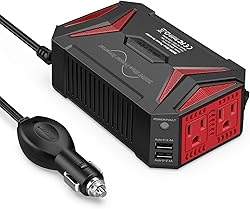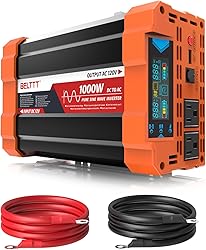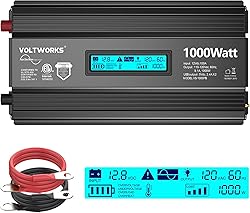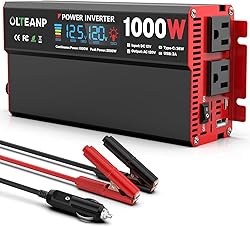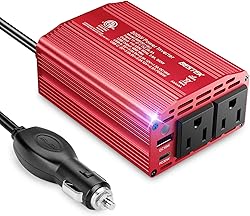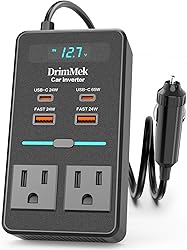Some road trips are about playlists and snacks, but others involve charging laptops, running a slow cooker at a rest stop, or keeping camera gear powered while chasing the perfect landscape shot. That’s when a good power inverter becomes more than just a convenience. I’ve spent enough time living and working out of my car to know that not all inverters are built the same. Finding the best power inverter for cars came down to real-world testing across a handful of models—some that delivered smooth power and others that nearly fried my gear.
Best Power Inverters For Cars in 2025
| Image | Model | Waveform | Wattage | |
|---|---|---|---|---|
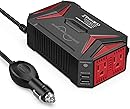 | Best Value Pure Sine Inverter BESTEK 300W InverterEditor's Choice | Pure Sine Wave | 300W | Check Price |
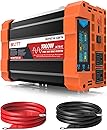 | Best Pure Sine Power Solution BELTTT 1000W Inverter | Pure Sine Wave | 1000W | Check Price |
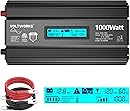 | Pure Sine Pro Grade Power VOLTWORKS 1000W Inverter | Pure Sine Wave | 1000W | Check Price |
 | Best Pure Sine for Road Trips BESTEK 500W Inverter | Pure Sine Wave | 500W | Check Price |
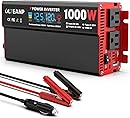 | Best for Light-Duty Mobile Power Needs OLTEANP 1000W Inverter | Modified Sine Wave | 1000W | Check Price |
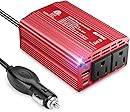 | Best Budget Modified Sine BESTEK 300W Inverter | Modified Sine Wave | 300W | Check Price |
 | Most Compact Design DrimMek 300W Inverter | Modified Sine Wave | 300W | Check Price |
 | Best Compact Inverter for Multi-Device Charging ALLWEI 300W Inverter | Modified Sine Wave | 300W | Check Price |
1. BESTEK 300W Pure Sine Wave Inverter
After putting it through real-world paces, I can say the BESTEK 300W Pure Sine Wave Power Inverter is a mighty impressive little unit. Whether I’m keeping a laptop powered while tackling work in the passenger seat or juicing up devices through the built-in USB ports, its performance is smooth and reliable. And that pure sine wave output? Exactly what you want for protecting sensitive tech like laptops, monitors, or drone batteries—anything that really cares about the quality of its power source.
Running my gear through it felt no different than plugging into a home outlet. Even during a long trip, with prolonged laptop use and simultaneous phone charging, I didn’t get any overheating or signal hiccups. It’s built solid too—aluminum housing, active cooling fan, and enough safeguards built-in to make me relax a bit more when powering up. Just remember, if you’re connecting devices over 150W, you’ll need to use the battery clamps to connect directly to your car’s battery instead of the cigarette lighter port.
Pros:
- Clean, pure sine power—safe for sensitive electronics
- USB ports detect and charge devices quickly
- Compact and solid aluminum build for durability
- Excellent protection circuitry built in
Cons:
- Cooling fan can be a bit noticeable when active
- No battery clamps included for direct connection
2. BELTTT 1000W Pure Sine Inverter
If you’re setting up a small off-grid system or just want reliable backup power for essentials in your vehicle or RV, this BELTTT 1000W inverter is an impressive contender. I wired it into my camper off a 12V lead-acid battery using some solar panels, and it handled all my basics just fine—laptop, TV, and even my air purifier. Getting it up and running took less time than brewing coffee, and I appreciated that the terminals use secure nuts and washers instead of those frustrating twist knobs that never seem to tighten right.
What stands out here is the clean sine wave output. It keeps sensitive electronics humming smoothly without weird interference or hums. The LCD screen gives you the kind of real-time info that makes troubleshooting a breeze—input/output voltage, load, and even error codes if something goes sideways. And let me tell you, it’s quiet. The fan engages only when necessary, so this inverter won’t drive you crazy in a small space. While it’s not going to run your fridge and AC at the same time, it’s a beast for its power class. Makes me kind of wish I’d picked up the 3000W version, but this one still earns its spot in my rig any day.
Pros:
- Pure sine wave output ideal for sensitive electronics
- Very quiet fan operation and solid thermal control
- LCD screen gives useful real-time system info
- Secure, durable power terminals and good build quality
Cons:
- Bar graph for load isn’t as informative as numeric readout
- Fuse replacement isn’t well explained in the manual
3. VOLTWORKS 1000W Pure Sine Inverter
I’ve been around the block with power inverters, and the VOLTWORKS 1000W is one of those rare finds that delivers more than expected without costing a fortune. Right off the bat, setup was simple — the unit feels sturdy with its all-metal housing and clean layout. I put it to work in my emergency backup setup, running off a 100ah battery. And true to its promise, it kept the essentials humming during an outage: fridge, lights, and even snuck in a coffee maker at one point.
The pure sine wave output makes a difference if you’re running sensitive electronics, and I appreciated the quiet fan that only spun up under load. Plus, the display gives a solid read on voltage and output without being cluttered. The USB ports were a nice bonus for charging gadgets during downtime. One quirk though — that screen isn’t the most forgiving from off-angles. I had to be right in front of it to see the readout clearly.
This inverter is a hard one not to recommend if you’re building out a dependable solar or vehicle-based power setup. It plays nicely with lithium batteries, too. So whether you’re setting up your RV, prepping for outages, or just want stable off-grid juice — this unit holds up its end.
Pros:
- Pure sine wave output handles sensitive electronics smoothly
- Quiet operation with smart cooling fan
- Durable metal build and compact size
- Clear and informative LCD display
- Includes quality cables and extras like fuses
Cons:
- Screen visibility is limited at off-angles
- Black power switch hard to spot in low light
4. BESTEK 500W Pure Sine Wave Inverter
I’ve tested a bunch of inverters over the years, but the BESTEK 500W Pure Sine Wave model really caught my attention — mostly because it delivers clean, reliable AC power that doesn’t freak out sensitive electronics. If you’ve ever plugged something into a cheap modified sine wave inverter and watched it buzz, flicker, or just flat-out refuse to work, you’ll know what I’m talking about.
This one outputs the “real deal” waveform — just like your home wall socket — and it shows. I powered up a laptop, charged a phone, even inflated an air mattress using the alligator clamps directly on the car battery, and everything ran like clockwork. The dual USB ports came in handy too when I didn’t want to drain my main outlets. One thing I appreciate: the fan only kicks in when needed. It’s not whisper-silent, but it’s better than listening to a wind tunnel every time you want to charge your phone.
There are some caveats, though. If you’re planning to hit the full 500W, take note — plugged into your cigarette lighter, you’re capped at around 150W thanks to your car’s fuse. To unleash full power, you’ve got to clamp onto the battery directly. That said, for camping, road trips, or small power outages, this little guy is a champ.
Pros:
- Pure sine wave output — perfect for sensitive electronics
- AC and USB ports keep options flexible
- Solid heat management and thermal protection
- Compact, well-built, and easy to connect
Cons:
- Full wattage only accessible via battery clamps, not 12V socket
- Modest USB output might not charge larger devices quickly
5. OLTEANP 1000W DC to AC Inverter
If you’re looking to power up basic gear on a road trip, at a campsite, or while tailgating, this OLTEANP 1000W inverter might be all the muscle you need. I tried it recently while trimming pines at the far end of my property—plugged into my truck’s battery and it kept an electric pruner buzzing without a hiccup. For smaller tools and electronics, it held up impressively without me needing to break out a clunky generator.
The digital display is a nice touch—it lets me monitor both DC input and AC output, which is handy for spotting any voltage dips. There are two AC outlets, a USB-C port, and a standard USB, which makes keeping things like phones, speakers, or a fan going pretty convenient. Just don’t expect this unit to run your rice cooker or AC—heavy-duty appliances are outside its appetite. I appreciate the built-in safety protections too—they give peace of mind when you’re away from home power sources.
Pros:
- Plenty of ports including Type-C and USB
- Clear LCD for voltage and battery monitoring
- Handles small tools and devices reliably
- Quiet cooling fan with smart temperature management
Cons:
- Not suitable for high-demand appliances like ACs or cookers
- Cannot exceed 150W when using the cigarette lighter plug
6. BESTEK 300W Compact Car Inverter
I’ve used plenty of power inverters over the years, and this one from BESTEK hits a sweet spot between portability and power. It’s not large or flashy, but it gets the job done with minimal fuss. Whether I’m juicing up my laptop or charging phones during road trips, it’s handled everything I’ve thrown at it — with two AC outlets and dual USB ports, it offers flexible options for essential gear.
One thing I particularly appreciate is the size — about as big as a smartphone, so it tucks neatly in my center console. The metal housing feels solid and has shrugged off the occasional jostle or drop. I’ve also used it to keep my tools and cooler running in the back of a work vehicle. Just don’t expect to run high-powered devices endlessly — it’s 300 watts continuous, so anything above that might push its limits. And like many inverters, keep in mind your car’s fuse rating if you try to crank too much power through the 12V outlet.
Pros:
- Super compact and easy to stash
- Dual AC and USB ports offer versatile charging
- Durable metal construction handles rough use
- Effective built-in safety features for protection
Cons:
- No direct battery clamps included for higher load use
- Can shut off if pushed near power limits via 12V socket
7. DrimMek 300W Compact Car Inverter
This DrimMek 300W car inverter has become my trusty co-pilot for road trips and backseat family chaos. From camping essentials to mobile work setups, it punches above its size class in convenience. I slipped it into my car’s console and haven’t looked back—it’s that compact. And despite the small footprint, it delivers reliable power with a well-balanced array of outputs: dual AC outlets, two USB-Cs, and two USB-As. One of those USB-Cs pushes 65W, and that’s been a game-changer for keeping my laptop thriving on long hauls.
The LED display is another solid touch—it shows vehicle voltage clearly so I know exactly what’s going on with my power draw. And while the built-in fan does kick in when I’m using an AC device, it keeps quiet enough not to disrupt podcasts or passenger naps. One small gripe: the cigarette lighter plug isn’t the most rugged. It works now, but I’ll be watching it for wear over time. Still, the convenience and versatility of this thing make it a mainstay in my vehicle. It’s kind of like having a mini charging station wherever I drive.
Pros:
- Compact and easy to store
- Multiple ports including fast-charging USB-C
- Clear LED power display
- Quiet operation even under load
Cons:
- Cigarette lighter plug feels a bit flimsy
- Not built for high-wattage appliances
8. ALLWEI 300W Car Power Inverter
This compact little powerhouse from ALLWEI surprised me with how much functionality is packed into such a small shell. I threw this into my glove box for weekend camping trips, and it’s been a reliable partner whether I’m inflating air mattresses or keeping my laptop charged while working road-side. It plugs straight into the 12V port, and the built-in AC outlets and USB ports make it hugely versatile.
The aluminum casing gives it a rigid, durable feel, and the fan—though definitely audible when the car is idling—is quieter than expected when you’re cruising with some background noise. Fast charge ports for USB-C and USB-A are a nice touch for topping up phones and smaller gadgets. Now, it’s not a pure sine wave inverter, so sensitive electronics might not love it, and those dual AC outlets are a bit too close together—chunkier plugs will block each other. But for road warriors or digital nomads looking for a budget-friendly 300W inverter, it does more than just get the job done.
Pros:
- Compact and travel-friendly size
- Good mix of fast-charging ports and AC outlets
- Solid metal construction for durability
- Reliable customer support and warranty
Cons:
- AC ports too close together for larger plugs
- Not ideal for high-draw or sensitive electronics
Power Output: Matching Your Needs Without Overloading
Here’s the thing about power inverters — most people either go way too small or ridiculously oversized. Start by adding up the wattage of everything you actually plan to run simultaneously, then add 20% for safety margin. That laptop charger might say 65 watts, but it probably pulls closer to 80 during startup. Don’t ask how I know, but I’ve seen too many guys blow fuses because they calculated everything perfectly on paper.
Your car’s electrical system has limits, and pushing beyond them is asking for trouble. Most standard vehicles can handle around 150-200 watts continuously without stressing the alternator, while larger trucks might manage 400 watts. The FMCSA regulations actually specify power limitations for commercial vehicles, and those guidelines make sense for personal use too — they know what they’re talking about when it comes to not frying electrical systems.
Waveform Types: Pure Sine vs Modified Sine
Pure sine wave inverters cost more, but they’re worth it if you’re running anything with a motor, sensitive electronics, or medical equipment. Modified sine wave inverters work fine for basic stuff like phone chargers and LED lights, but I’ve seen them make fans whine, cause laptop power supplies to run hot, and generally act finicky with modern electronics.
If you’re powering anything that plugs into the wall at home without issues, go pure sine wave. Trust me, the extra cost beats dealing with compatibility problems down the road. I learned this the hard way when a modified sine wave inverter fried a customer’s CPAP machine during a camping trip — that was not a fun conversation.
Installation and Safety Considerations
Battery connection matters more than most people realize. Those flimsy alligator clips that come with cheaper inverters? They’re basically guaranteed to give you voltage drop and heating issues under load. Direct battery terminal connections with proper fusing are the only way to go for anything over 150 watts. I’ve seen melted clips, burned-out cigarette lighter sockets, and even dashboard fires from people trying to push too much power through inadequate connections.
Ventilation is another thing people ignore until it’s too late. These things generate heat — lots of it. Stick an inverter under a seat or in a closed compartment, and you’ll be shopping for a new one sooner than you think. The NIOSH mobile power safety guidelines emphasize proper ventilation for good reason — overheated inverters don’t just fail, they can become fire hazards.
Grounding and Interference
Proper grounding isn’t optional, despite what some YouTube videos might suggest. A solid ground connection to your vehicle’s chassis prevents interference with your radio, GPS, and other electronics. The FCC has specific regulations about electromagnetic interference from automotive power devices, and cheap inverters without proper shielding can wreak havoc on your car’s electronics.
I once spent three hours diagnosing a mysterious radio static issue that turned out to be a poorly grounded inverter in the trunk. The fix took five minutes once I found the problem, but those three hours of troubleshooting? That’s time I’ll never get back.
Vehicle Compatibility and Electrical System Health
Not all vehicles are created equal when it comes to handling aftermarket power loads. Newer cars with complex computer systems can be more sensitive to electrical modifications than older, simpler vehicles. The NHTSA vehicle electrical safety standards provide good guidelines, but they don’t account for every possible combination of car and inverter.
Check your alternator capacity before committing to a high-wattage inverter. Most passenger car alternators produce 80-120 amps, but that doesn’t mean you can use all of it for your inverter — the engine, lights, air conditioning, and other systems need power too. A good rule of thumb is to keep continuous inverter draw under 25% of your alternator’s rated output.
- Compact cars: Stick to 150-300 watts maximum
- Mid-size vehicles: 300-500 watts is usually safe
- Full-size trucks/SUVs: Can often handle 600-800 watts
- Commercial vehicles: Follow manufacturer specifications
Features That Actually Matter
Forget the fancy LED displays and USB ports — focus on the protection features that keep your inverter and vehicle safe. Look for low voltage disconnect, over-temperature protection, and short circuit protection as non-negotiables. These aren’t marketing gimmicks; they’re the difference between a minor inconvenience and a major electrical disaster.
Remote control capability is actually useful if you’re mounting the inverter somewhere inconvenient. I’ve installed units in truck beds and RV compartments where reaching the power switch would require contortion skills I lost about twenty years ago. The remote saves your back and makes the whole setup more practical for regular use.

